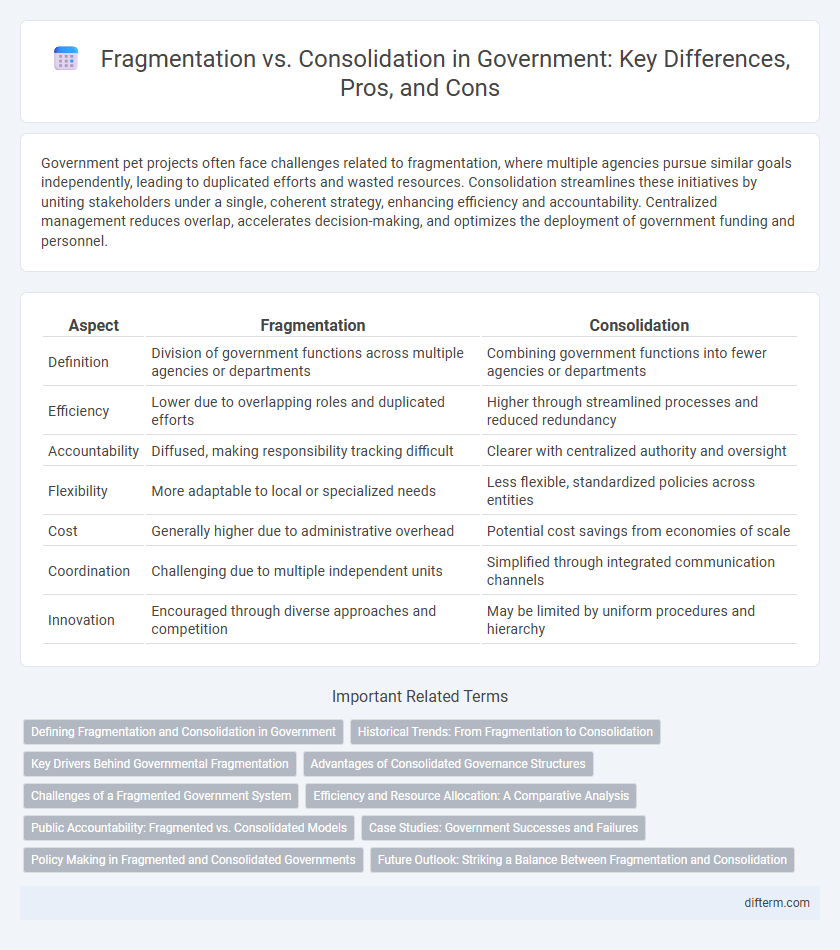Government pet projects often face challenges related to fragmentation, where multiple agencies pursue similar goals independently, leading to duplicated efforts and wasted resources. Consolidation streamlines these initiatives by uniting stakeholders under a single, coherent strategy, enhancing efficiency and accountability. Centralized management reduces overlap, accelerates decision-making, and optimizes the deployment of government funding and personnel.
Table of Comparison
| Aspect | Fragmentation | Consolidation |
|---|---|---|
| Definition | Division of government functions across multiple agencies or departments | Combining government functions into fewer agencies or departments |
| Efficiency | Lower due to overlapping roles and duplicated efforts | Higher through streamlined processes and reduced redundancy |
| Accountability | Diffused, making responsibility tracking difficult | Clearer with centralized authority and oversight |
| Flexibility | More adaptable to local or specialized needs | Less flexible, standardized policies across entities |
| Cost | Generally higher due to administrative overhead | Potential cost savings from economies of scale |
| Coordination | Challenging due to multiple independent units | Simplified through integrated communication channels |
| Innovation | Encouraged through diverse approaches and competition | May be limited by uniform procedures and hierarchy |
Defining Fragmentation and Consolidation in Government
Fragmentation in government refers to the division of authority and responsibilities across numerous agencies and departments, often leading to overlapping functions and inefficiencies. Consolidation involves merging these entities to streamline operations, improve coordination, and reduce administrative costs. Understanding the balance between fragmentation and consolidation is essential for optimizing public sector governance and service delivery.
Historical Trends: From Fragmentation to Consolidation
Historical trends in government reveal a notable shift from fragmentation toward consolidation, characterized by the merging of smaller administrative units into larger entities to enhance efficiency and governance. This evolution reflects efforts to streamline decision-making, improve resource allocation, and foster cohesive policy implementation across regions. Data from multiple countries indicate that consolidated governments often achieve better service delivery and reduced administrative costs compared to fragmented systems.
Key Drivers Behind Governmental Fragmentation
Governmental fragmentation is driven by factors such as diverse political interests, jurisdictional overlaps, and varying administrative capacities across regions. Decentralization policies and local autonomy demands intensify the proliferation of governmental units, complicating coordination and policy coherence. Fiscal disparities and differing resource allocations further exacerbate fragmentation, limiting unified government responses.
Advantages of Consolidated Governance Structures
Consolidated governance structures in government enhance operational efficiency by reducing redundant departments and streamlining decision-making processes. Centralized authority fosters better resource allocation and uniform policy implementation, leading to improved public service delivery. Clearer accountability mechanisms emerge, enabling more transparent oversight and increased public trust.
Challenges of a Fragmented Government System
A fragmented government system often results in overlapping responsibilities, inefficient resource allocation, and inconsistent policy implementation across various agencies. Communication barriers and lack of centralized authority hinder coordinated decision-making, leading to delayed responses to public issues. This fragmentation complicates accountability structures, making it difficult to track performance and enforce regulations effectively.
Efficiency and Resource Allocation: A Comparative Analysis
Fragmentation in government agencies often leads to duplicated efforts and inefficient resource allocation, resulting in increased administrative costs and slower decision-making processes. Consolidation streamlines operations by integrating functions and sharing resources, improving overall efficiency and enabling better budget management. Comparative analysis shows that consolidation enhances policy coherence and service delivery while reducing redundancies.
Public Accountability: Fragmented vs. Consolidated Models
Fragmented government models often dilute public accountability by dispersing authority across multiple agencies, making it difficult for citizens to identify responsibility for policy outcomes. Consolidated structures enhance transparency and streamline oversight by centralizing decision-making powers, which improves the ability to hold officials answerable. Studies have shown that consolidated models lead to clearer responsibility lines, thus strengthening democratic governance and public trust.
Case Studies: Government Successes and Failures
Government initiatives demonstrate that fragmentation often leads to duplicated efforts and resource inefficiencies, as seen in the U.S. Department of Homeland Security's early challenges. Conversely, consolidation efforts like Singapore's integrated public service model highlight improved policy coordination and service delivery. Case studies emphasize that strategic consolidation can enhance governance effectiveness, while poorly managed fragmentation risks operational setbacks.
Policy Making in Fragmented and Consolidated Governments
Fragmented governments face challenges in policy making due to competing interests among multiple agencies, leading to slower decision-making and inconsistent implementation. Consolidated governments benefit from streamlined authority, enabling cohesive policy development and more efficient resource allocation. Effective policy outcomes often depend on balancing coordination in fragmentation with the agility of consolidation.
Future Outlook: Striking a Balance Between Fragmentation and Consolidation
Government strategies must navigate the tension between fragmentation, which allows for localized innovation and responsiveness, and consolidation, which promotes efficiency and uniformity across agencies. Emerging technologies and data integration tools enable a hybrid approach, fostering collaboration while maintaining autonomy where necessary. Future Outlook emphasizes adaptive governance models that balance decentralization benefits with centralized oversight to enhance policy effectiveness and public service delivery.
Fragmentation vs Consolidation Infographic

 difterm.com
difterm.com